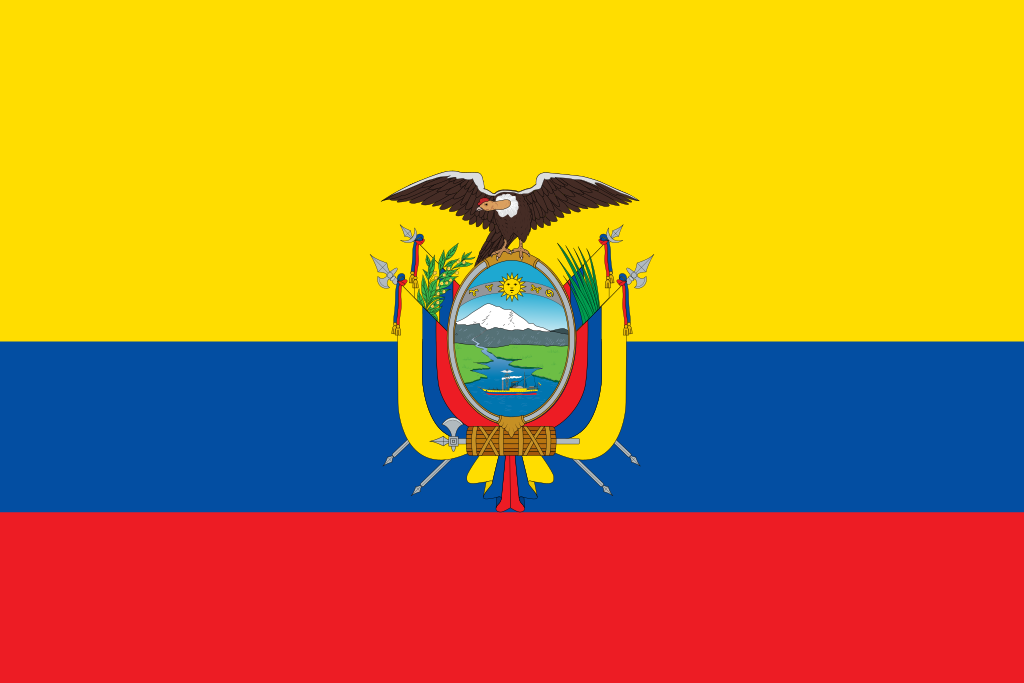Flag Description:
The flag of Ecuador is an elegant tricolor masterpiece, comprised of three horizontal bands of equal width artfully arranged from top to bottom: luminous yellow, deep blue, and vibrant red. Adhering to a common proportion of 2:3 (height to width), variations may be encountered. Positioned at the convergence of the blue and yellow stripes lies the national coat of arms, a central emblem of remarkable significance.
Symbolism:
The Ecuadorian flag's rich tapestry of colors and motifs serves as a potent tableau embodying the nation's historical narrative, geographical essence, and aspirational journey:
Yellow (Top Stripe):
A beacon of Ecuador's prosperity, the luminous yellow evokes the nation's abundant natural resources—be it the lustrous yield of minerals or the fertile bounty of agriculture.
An emblem of the country's fecund terrain, the yellow stripe also resonates with the kaleidoscope of cultures that thrive within its borders.
Blue (Middle Stripe):
The middle azure band serves as a reverent nod to the pristine skies that cradle Ecuador and the boundless expanse of the Pacific Ocean lapping at its shores. By nestling between heaven and sea, the blue stripe encapsulates the nation's geographical nexus.
Red (Bottom Stripe):
The crimson lowermost stripe is steeped in profound significance, commemorating the valorous sacrifice of Ecuador's heroes and martyrs during the arduous struggle for autonomy and sovereignty.
It stands as an embodiment of the Ecuadorian people's courage, resilience, and unwavering commitment to liberty.
Coat of Arms:
The centerpiece of the Ecuadorian flag, the national coat of arms, is a tableau of intricate symbols that enrich its narrative:
Condor:
Majestic and resplendent, the condor, perched atop the tableau, pays homage to the revered Andean region.
It emerges as a totem of freedom, endowed with the soaring prowess of the Andes' lofty peaks, embodying Ecuador's quest for greatness.
Chimborazo Volcano:
Positioned beneath the condor, the Chimborazo volcano, a sentinel of Ecuador's landscape, asserts its prominence as the nation's loftiest pinnacle.
The volcano echoes the country's topographical diversity, encompassing mountains, volcanic majesty, and fertile valleys.
River:
From the volcano's foothills courses a river, emblematic of Ecuador's profusion of waterways and fertile terrains that nurture life and cultivate agriculture.
Sun:
Emerging radiantly from behind the volcano, the sun casts forth 24 resplendent rays, a reminder of Ecuador's journey towards enlightenment and a rejuvenated era.
An homage to the Inca sun god Inti, it also honors the indigenous heritage intrinsic to the nation's identity.
Laurel Wreath:
Encompassing the tableau, a laurel wreath weaves laurel leaves in a circular embrace, signifying triumph, honor, and accomplishment.
It is a poignant tribute to the Ecuadorian people's victories and the indomitable spirit that guided them to independence.
Historical Significance:
This emblem, conceived during Juan José Flores' presidency from 1830 to 1834, and officially adopted on September 26, 1860, under Gabriel García Moreno's leadership, reverberates with historical resonance. Its hues and motifs resonate as an ode to Ecuador's trials, endurance, and dreams.
In summation, the Ecuadorian flag is a resplendent tapestry intricately woven with cultural threads, encapsulating the nation's intrinsic allure, cultural treasures, historical heritage, and the tenacious fervor that courses through the veins of its populace.
Last Updated on: August 08, 2023